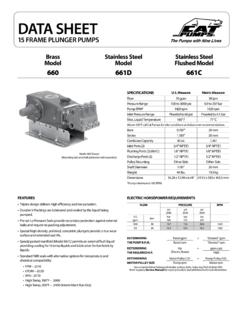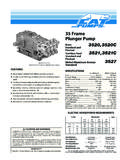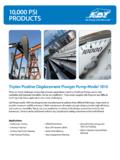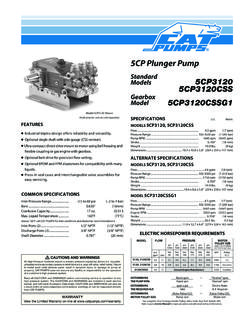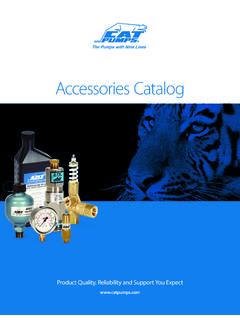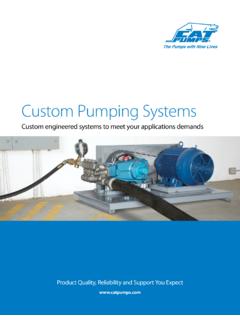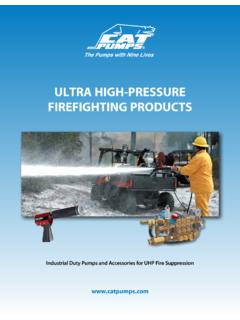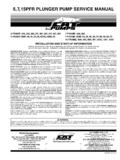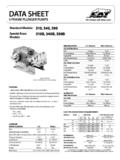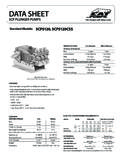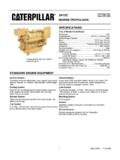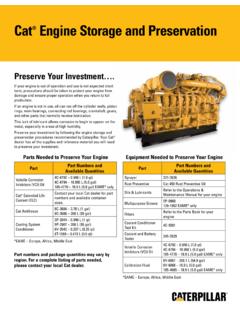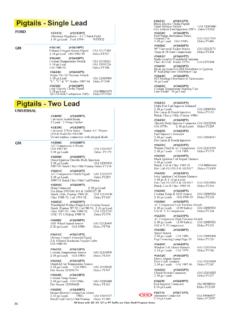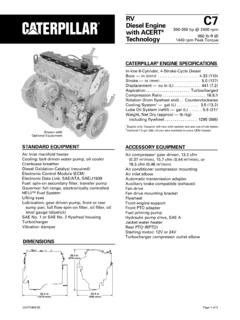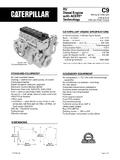Transcription of Safety Data Sheet Cat Pump Crankcase Oil ISO 68 Revision ...
1 Safety data Sheet Cat Pump Crankcase Oil ISO 68. Revision Date: 10/1/15. Prepared according to Global Harmonized System (GHS) standards SECTION 1 CHEMICAL PRODUCT IDENTIFICATION. Cat pumps 1681 94th Lane NE., Minneapolis, MN 55449-4324. Tel: 763-780-5440. Product Trade Name: Crankcase Oil ISO 68 Special Formula Premium Grade CAS Number: Mixture Synonyms/Other: N/A. Part Number(s): 6100, 6102, 6105, 6107, 6109, 6123 and 6126. Recommended Use: Pump Oil Restrictions on Use: Not determined Created Date: 2/17/2015. Preparation/ Revision Date: 10/1/2015. Emergency Phone Number: N/A. SDS CODE: 10410. SECTION 2 HAZARD IDENTIFICATION. Appearance: Clear, Dark Green Odor: Petroleum Classification: T his material is not considered to be hazardous according to the Globally Harmonized System of Classification and Labelling Chemicals (GHS), Third Revised Edition.
2 Target Organs: Not applicable. Pictogram(s): None required. Signal Word: None required. Hazard Statement: Not required. Other Hazards: Not determined. Prevention: None required. Response: None required. Storage Procedures: None required. Disposal: None required. Other: See section 11 for complete health hazard information. SECTION 3 COMPOSITION OF INGREDIENTS. No Hazardous Substance(s) or Complex Substance(s) required for disclosure. SECTION 4 FIRST AID MEASURES. Eye Contact: I f irritation occurs, cautiously rinse eyes with lukewarm, gently flowing water for 5 minutes, while holding the eyelids open. If eye irritation persists: Get medical advice/attention. Skin Contact: Call a doctor if you feel unwell. Inhalation: Get medical advice or attention if you feel unwell or are concerned.
3 Ingestion: I f you feel unwell or concerned: Get medical advice/attention. Rinse mouth. Do NOT induce vomiting. If vomiting occurs naturally, lie on your side, in the recovery position. Other: No additional information Page 1 of 6. Safety data Sheet Cat Pump Crankcase Oil ISO 68. Revision Date: 10/1/15. SECTION 5 FIRE FIGHTING MEASURES. Flash Point: 204 C by Cleveland Open Cup Tester. Flammable limits: Not determined. Extinguishing media: Use dry chemical, alcohol foam, all purpose AFFF or carbon dioxide to extinguish fire. Special firefighting procedures: O NOT direct a solid stream of water or foam into hot, burning pools of liquid since this may cause frothing and D. increase fire intensity. Frothing can be violent and possibly endanger any firefighter standing too close to the burning liquid.
4 Use water spray to cool fire exposed containers and structures until fire is out if it can be done with minimal risk. Avoid spreading burning material with water used for cooling purposes. Wear full firefighting turn-out gear (full Bunker gear), and respiratory protection (SCBA). Unusual fire & explosion hazards: ense smoke may be generated while burning. Toxic fumes, gases or vapors may evolve on burning. High D. temperatures may create heavy flammable vapors that may settle along ground level and low spots to create an invisible fire hazard. Byproducts of combustion: F ires involving this product may release oxides of carbon, phosphorus, nitrogen and sulfur; reactive hydrocarbons and irritating vapors. Autoignition temperature: Not determined.
5 Explosion data : Not determined. Care should always be exercised in dust/mist areas. Other: Dispose of fire debris and contaminated extinguishing water in accordance with official regulations. SECTION 6 ACCIDENTAL RELEASE MEASURES. Spill control procedures (land): I mmediately turn off or isolate any source of ignition (pilot lights, electrical equipment, flames, heaters, etc.). Evacuate area and ventilate. Personnel wearing proper protective equipment should contain spill immediately with inert materials (sand, earth, chemical spill pads of cotton) by forming dikes. Dikes should be placed to contain spill in a manner that will prevent material from entering sewers and waterways. Large spills, once contained, may be picked up using explosion proof, non-sparking vacuum pumps , shovels, or buckets, and disposed of in suitable containers for disposal.
6 If a large spill occurs notify appropriate authorities. In case of road spill or accident contact ChemTrec (800-424- 9300). Spill control procedures (water): T ry to contain large spills with floating booms to prevent spill from spreading. Remove from surface by skimming or with suitable adsorbents. If a large spill occurs notify appropriate authorities (normally the National Response Center or Coast Guard at 800- 424-8802). Waste disposal method: o not empty into drains. All disposals must comply with federal, state, and local regulations. The material, if D. spilled or discarded may be a regulated waste. Refer to state and local regulations. Department of Transportation (DOT) regulations may apply for transporting this material when spilled.
7 See Section 14. Other: AUTION - If spilled material is cleaned up using a regulated solvent, the resulting waste mixture will be C. regulated. SECTION 7 HANDLING AND STORAGE. Handling procedures: Keep containers closed when not in use. Do not transfer to unmarked containers. Empty containers retain product residue which may exhibit hazards of material, therefore do not pressurize, cut, glaze, weld, or use for any other purposes. Return drums to reclamation centers for proper cleaning and reuse. Handling temperatures should not exceed 60 C (140 F) to minimize danger of burns. Open containers carefully in a well ventilated area or use appropriate respiratory protection. Wash thoroughly after handling. Storage procedures: S tore containers away from heat, sparks, open flame, or oxidizing materials.
8 Extended storage at excessive temperatures may produce odorous and toxic fumes from product decomposition. Additional information: No additional information. Page 2 of 6. Safety data Sheet Cat Pump Crankcase Oil ISO 68. Revision Date: 10/1/15. SECTION 8 EXPOSURE CONTROLS / PERSONAL PROTECTION. Exposure limits/standards for materials that can be formed when handling this product: Contains highly refined OSHA TWA OSHA STEL ACGIH TWA. petroleum oil *5 mg/m (PEL) *10 mg/m *5 mg/m (TLV). * Exposure limits not defined. Limits used are for, oil mist . TWA Time Weighted Average is the employee's average airborne exposure in any 8-hour work shift of a 40-hour work week which shall not be exceeded. STEL Short Term Exposure Limit is the employee's 15-minute time weighted average exposure which shall not be exceeded at any time during a work day unless another time limit is specified.
9 All base oils, including additive carriers, contain < DMSO extractable material. Personal protection: pplicable mainly to persons in repeated contact situations such as packaging of product, service/maintenance, A. and cleanup/spill control personnel. Respiratory protection: one required if ventilation is adequate. Otherwise a respiratory protection program meeting OSHA N. and ANSI requirements must be followed. Where misting may occur, wear an MSHA/NIOSH approved (or equivalent) half-mask form dust/mist air purifying respirator. Eye protection: E ye protection is strongly recommended. Wear Safety glasses with side shields or vented/splash proof goggles (ANSI or approved equivalent). Hand protection: Impervious, chemically resistant gloves such as neoprene or nitrile rubber to avoid skin sensitization and absorption.
10 Other protection: se of an apron and overboots of chemically impervious materials such as neoprene or nitrile rubber is U. recommended based on level of activity and exposure. If handling hot material use insulated protective equipment. Launder soiled clothes. Properly dispose of contaminated leather articles and other materials which cannot be decontaminated. Local control measures: se adequate ventilation when working with material in an enclosed area. Mechanical methods such as fume U. hoods or area fans may be used to reduce localized vapor/mist areas. If vapor or mist is generated when the material is handled, adequate ventilation in accordance with good engineering practice must be provided to maintain concentrations below the specified exposure.
